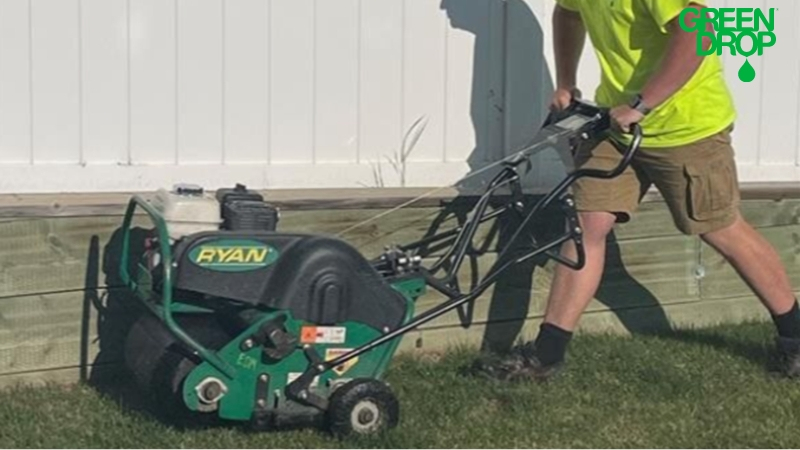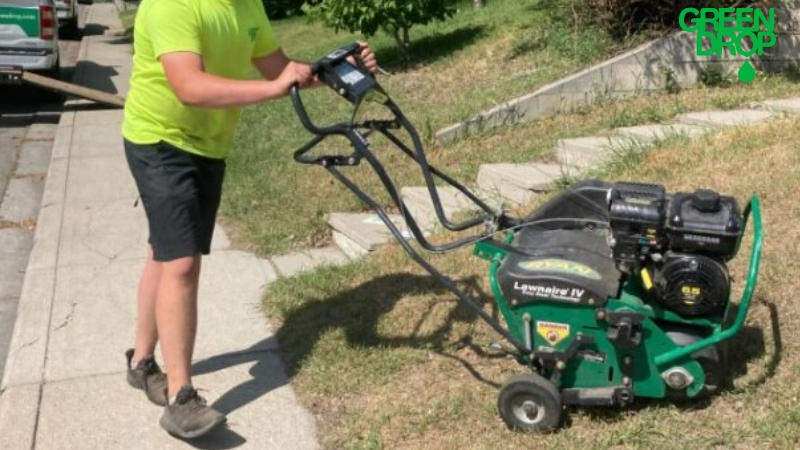Core Aeration vs. Spike Aeration - All You Need to Know
Reading time: 6 minutesLet's face it; maintaining a healthy lawn is more than just mowing and watering. It's about letting it breathe through proper aeration. And aeration isn’t just poking holes in your grass; it’s a tactical move that can bring life to your lawn if done right.
But not all aeration is created equal.
Today, we're explaining why core aeration is what the doctor ordered for most homes. We’ll also look at spike aeration and why it’s more of a quick back scratch that is better suited for the sandy stretches of a golf course.
Let's dig in and clear the air about which aeration method really helps your lawn.

Core Aeration vs. Spike Aeration
Feature | Core Aeration | Spike Aeration |
Method | Removes plugs of soil | Punches holes in the soil |
Soil Displacement | Yes, removes soil to reduce compaction | No, potentially increases compaction |
Best Used On | Residential lawns with compact soil | Golf courses with sandy, loose soil |
Effect on Soil | Relieves compaction effectively | Can further compact the soil around holes |
Root Growth Promotion | Enhances root growth and health | Less impact on root growth |
Moisture and Nutrient Penetration | Improves significantly | Less effective; holes may close quickly |
Recommended Soil Type | Clay-heavy, dense soils | Sandy soils |
More about the two methods below.
Understanding Manual Core Aeration
Core aeration requires a specialized tool known as a core aerator. Our GreenKeepers manually go over your lawn and cover every inch of it, pulling out small cores or plugs of soil and thatch. These plugs are usually about half an inch wide and a few inches deep (take a look at the reference image below), spaced closely enough to optimize their effect without damaging the lawn.
This method of aeration provides certain benefits to your lawn:
- By removing plugs of soil, core aeration breaks up compacted soil layers, allowing roots to expand more freely. This deeper and healthier root system supports stronger, more resilient grass.
- It creates channels that help water penetrate deeper into the soil. This prevents waterlogging and ensures moisture reaches the roots where it’s most needed.
- Opened-up soil absorbs nutrients and water more efficiently because they infiltrate deeper into the soil rather than washing away or pooling on the surface.
Our GreenKeepers exclusively use core aeration for its numerous advantages.
All About Spike Aeration
Spike aeration entails using a roller with solid spikes that punch holes into the soil. Unlike core aeration, which removes plugs of soil to relieve compaction, spike aeration simply pushes the soil aside to create openings.
The spikes are typically several inches long and can be spaced variously depending on the tool used. Therefore, they are most effective in areas with sandy or loose soil, such as golf courses. The sandy composition allows the soil to collapse back around the holes over time, maintaining airflow and water infiltration without the risk of the compacted soil rebounding.
While spike aeration has its uses, it also has certain limitations, especially for residential lawns:
- Lawns usually have denser soils, and the action of pushing soil aside can actually compact it further around the holes. This reduces the effectiveness of aeration and potentially stresses the lawn further rather than alleviating existing compaction issues.
- Since no soil is actually removed, spike aeration does not offer as pronounced a benefit for relieving soil compaction as core aeration.
- The holes can close up quickly, especially in clay-rich soils. This negates the benefits of aeration too soon after it’s performed.
Spike aeration has its uses and can still offer significant benefits, but the soil needs to be sandy.

Why Core Aeration Is the Only Option for Your Yard
Core aeration is definitely the MVP when it comes to residential lawns. Let’s break down why it knocks spike aeration out of the park:
- Core aeration isn’t just poking at the surface. It digs in, pulling out plugs of soil to seriously loosen up compacted earth.
- Most residential lawns have tough soil types—think clay-rich stuff that’s hard for roots to wrestle through. Core aeration removes these tough chunks and gives roots the room they need to grow strong.
- With better aeration from those removed soil plugs, water seeps deeper into the ground instead of just puddling on the surface. This means less watering, less runoff, and a happier lawn.
- Unlike spike aeration, which can just push soil around and make compaction even worse (oops!), core aeration actually removes that tight, compacted soil. Less compaction means a softer bed for your lawn’s roots to spread out on.
- By creating these open spaces in the soil, air circulation gets a boost, too. Roots get access to more oxygen, which is like a power-up for their growth and health.
Core Aeration Tips for a Thriving Lawn
Getting the best out of core aeration is all about timing and technique. Hit all the right notes for a lush, healthy lawn by following our tips:
- Aim for core aeration in late spring or early fall. These seasons offer cooler temperatures and ample moisture that help your grass recover and grow robustly post-aeration. Plus, aerating in early fall gives your lawn a head start to rejuvenate before the winter chill sets in.
- Generally, aerating once a year does the trick. However, if you’ve got a high-traffic lawn or heavy clay soil, stepping it up to twice a year can help maintain its energy.
- Ideal conditions mean slightly moist soil, not too wet or bone-dry. Aerating a day after light rain or watering can make the process smoother and more effective. The cores come out easier, and the machine can penetrate the soil without straining.
- Before you start, clear the lawn of debris, toys, or large sticks that could obstruct the aerator. A clean lawn means a smoother run for your aerator and more effective aeration.
Supercharging Your Lawn Care with Core Aeration
Core aeration isn't just a standalone task—it’s part of your overall lawn care plan. When used correctly, aeration enhances every aspect of lawn care.
Core aeration creates open spaces in the soil, setting the stage for more effective overseeding. The seeds find a cozy spot in the openings left by the plugs, improving seed-to-soil contact and germination rates. This means thicker, more even grass coverage as the young seedlings take root in an ideal growing environment.
Additionally, aeration amplifies the benefits of fertilization and proper watering. With the soil loosened, nutrients from fertilizers penetrate deeper and are absorbed more efficiently by the root system. This leads to a greener, more robust lawn as the roots access all the nourishment they need to grow strong.
Similarly, watering becomes more effective post-aeration. Water reaches deeper into the soil, reducing surface runoff and promoting optimal moisture levels in the root zone.

Aerate Your Way to Awesome with Green Drop
Is your lawn looking sparse with compacted soil? Is it gasping for air? Give your lawn the pampering it deserves. From aeration to overseeding, fertilizing, and weed control, our GreenKeepers give your lawn the attention it needs to blossom.
Book your lawn care package today and head on your way to a healthier, more vibrant lawn.
At Green Drop, we believe in providing top-notch lawn care services throughout Western Canada, from Calgary, Edmonton, Red Deer, Regina, Saskatoon, and Winnipeg.
Remember, with Green Drop, you're not just caring for your lawn; you’re transforming it.

